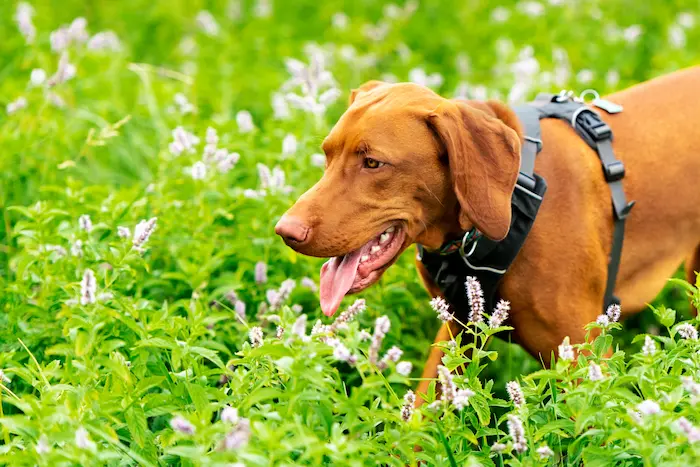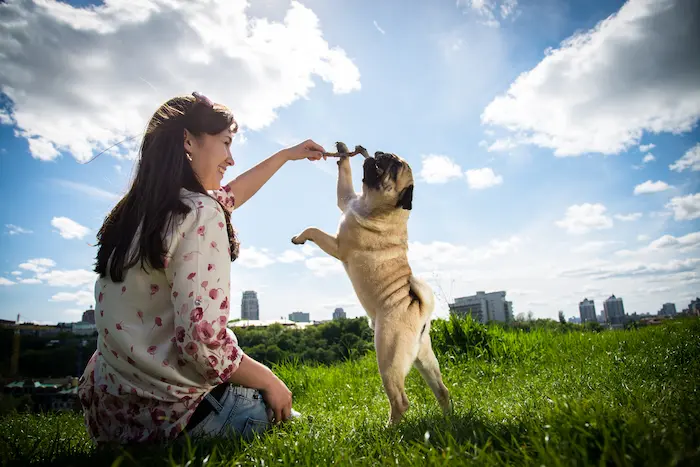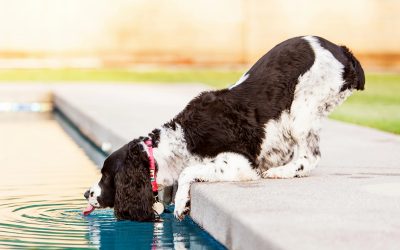Dog collars are more than simply fashion accessories for pups. They ensure your dog’s safety and aid in training. One dog may need several different types of collars throughout its life. A certain collar could be used for everyday wear at home, while another type is necessary for leash training.
Beyond their main uses, a collar may simply fit your dog’s neck in different ways. Some collars are more appropriate for a certain breed or for large dogs, or a collar may need to be specifically fitted to your furry friend. If you want to make sure your pet looks good, is comfortable, and can be properly trained in any situation, it’s important to know about the best dog collars so you can make an informed decision.
Flat Collars
Flat collars are the classic style you generally think of when considering a collar for your pet. They’re made of a flat piece of material that’s secured around the neck of your dog, generally with a metal or plastic buckle. These collars are available in many color combinations and materials, such as leather and nylon. You can shop for extra features on flat collars as well, such as neoprene padding for extra comfort or embroidered stitching for personalization. Some models even aid in training or keeping your pup within a certain boundary.
A flat collar is the choice of most pet owners. It’s perfect for daily use and, at a minimum, displays your pet’s ID tags. Your dog should never be without a collar, and a flat collar is safe for wearing day and night, in any situation.
On the positive side, flat collars tend to be very comfortable and quite safe for pets. They are usually inexpensive and can be easily replaced when worn out or outgrown. However, this basic collar can still hurt your dog if it gets caught on something or if you try to use it for training your dog and pull forcefully on it.
Martingale Collars
A martingale collar is one of the gentlest training collars to use to teach your dog how to walk on a leash. This style of collar is generally made primarily of nylon, much like a flat collar. However, there’s a small section of chain or a secondary nylon strap connected to one part of the collar. This part is designed to tighten on your pet’s neck when it pulls against the leash and then loosen again once it’s walking at an appropriate distance. Most collars like this don’t have buckles; they slip over your pet’s neck and tighten to a comfortable fit.
While it’s one of the safer options for training your dog, a martingale collar can be dangerous when misused. A jerking motion on the leash, or simply the actions of a very stubborn pet, can cause the collar to tighten beyond the point of discomfort and cause neck injuries. It must be used with caution.
When it comes to leash training your pup, a martingale collar is simple to use and is one of the least likely to injure your dog on walks. Simply using this style of collar won’t make your dog an expert overnight. It takes some effort and training on your part to teach your pet to trust and obey you. You may also pair this collar with other types of training collars and methods to provide the best results for your pup.
Head Collars
If you’ve tried training your dog to walk loosely on a leash but it’s still having a hard time, a head collar may be a good choice for you. Also called a head harness, this is one of the best dog collars for taking a resistant pup out on walks. It’s often confused with a muzzle, as the straps go over the snout and under the chin, but your dog can still open and close its mouth. Perhaps even more than other options, head collars are highly adjustable and must be fitted carefully to avoid discomfort or injury.
A dog wearing this type of collar can’t use all the strength of its body to pull against a leash. Instead, it can only use its head, and therefore, the pet is much easier to control. Some professionals consider this an ideal training tool, while others say it’s not useful for training and only appropriate for taking your dog out on a walk and being able to control it. Either way, be sure to get your pup adjusted to this collar before use.

Harnesses
If you have a dog that pulls on the leash and you’re afraid of hurting its neck, a harness may suit you both. Available in a wide array of colors, patterns, and materials, harnesses are a great choice for dogs of any age. Often, a dog will wear its collar to keep tags accessible, with a harness used for walking and other activities.
Your furry friend may be skeptical of the harness when first putting it on, but a few treats and fun walks should cure this quickly. A harness keeps a leash from getting tangled under your dog’s legs and spreads any force across the strong chest and shoulder areas, helping avoid injuries. Harnesses are particularly helpful for a young pup that hasn’t yet learned how to walk on a loose leash.
Front clip harnesses connect to the leash with a D-ring on the dog’s chest. The tension discourages your pet from pulling and can help train it. However, extended use of this type of collar can actually harm your dog, preventing it from walking correctly and even changing its gait over time. As with all collars, be sure you can fit two fingers between it and your dog for proper sizing.
Breakaway Collars
Another collar to consider for your pet is a breakaway collar. These are especially great for a pet that might be left alone for some period of time. It’s worn about the neck, much like a standard flat collar; however, the buckle is engineered to tear away with pressure. This prevents injuries when a dog is not directly monitored. If it gets stuck on a fence or another hazard, it will be able to safely get away.
This type of dog collar isn’t necessary if you always have your dog visible or if it’s never left alone. There’s the potential that if this dog collar is used all the time, it could come apart on walks or in other situations when you need to have your dog restrained. Using this type of collar only when you’re away from your dog while using a different type on walks or at other times, may be the best choice.
Choosing the Best Dog Collar for Your Pup
For most dogs, a combination of different collars targeted at specific situations is the best possible choice. If you’re really looking for one dog collar that’s durable and covers multiple situations, consider a Halo Collar. While appearing much like the ideal flat collar, it also helps train your pup how to stay inside a given boundary, so you have fewer worries about losing your dog. That peace of mind is one of the biggest factors you should consider when finding the best dog collar to purchase.










